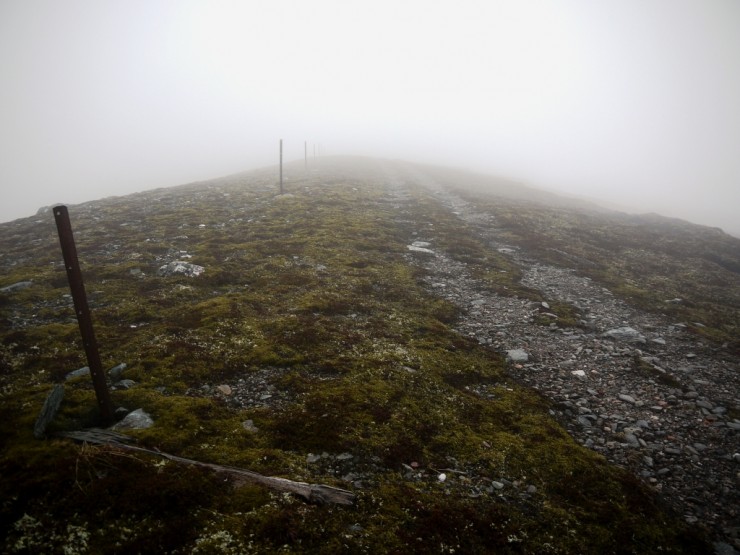The Dragon’s breath
4th April 2016
 (Above)Â The ‘dragon’s breath’ swirling around the trees. Misty, moisty morning near Spey Dam en route to Coire a Bheinn.
(Above)Â The ‘dragon’s breath’ swirling around the trees. Misty, moisty morning near Spey Dam en route to Coire a Bheinn.
 (Above) Was checked out by deer at about 500m.
(Above) Was checked out by deer at about 500m.
 (Above) Visibility even worse at 600m
(Above) Visibility even worse at 600m
 (Above) The ‘road to nowhere’ on the broad ridge above Carn Dubh at 800m skirting Coire a Bheinn (to the right of shot). Remains of some Victorian fencing along the watershed and marking the boundary between two estates. The posts extend right across the Carn Liath plateau and make a useful ‘handrail’ when navigating hereabouts in bad weather. The rotten wooden fencepost on the ground post-dates the substantial iron work. Evidence elsewhere of wooden posts inserted into the non-existent soil in an effort to patch up the fence line.
(Above) The ‘road to nowhere’ on the broad ridge above Carn Dubh at 800m skirting Coire a Bheinn (to the right of shot). Remains of some Victorian fencing along the watershed and marking the boundary between two estates. The posts extend right across the Carn Liath plateau and make a useful ‘handrail’ when navigating hereabouts in bad weather. The rotten wooden fencepost on the ground post-dates the substantial iron work. Evidence elsewhere of wooden posts inserted into the non-existent soil in an effort to patch up the fence line.
 (Above) They don’t make like they used to! Every single iron post inserted into bedrock or boulders….and still standing.
(Above) They don’t make like they used to! Every single iron post inserted into bedrock or boulders….and still standing.
 (Above) Scratched the surface to reveal lead. The Victorian fencing gang would have bored a hole (with hand tools), inserted the post then poured molten lead into the void to firmly embed and secure the post. Proper workmanship! It beggars belief that fires were lit up here (at 800-900m) to melt base metal. Must have been done in batches of 20 posts or so, surely?
(Above) Scratched the surface to reveal lead. The Victorian fencing gang would have bored a hole (with hand tools), inserted the post then poured molten lead into the void to firmly embed and secure the post. Proper workmanship! It beggars belief that fires were lit up here (at 800-900m) to melt base metal. Must have been done in batches of 20 posts or so, surely?
 (Above) Snow patches in Coire a Bheinn above the Upper Spey. Thawing and generally stable. Some glide cracks apparent and a few old slumped cornices.
(Above) Snow patches in Coire a Bheinn above the Upper Spey. Thawing and generally stable. Some glide cracks apparent and a few old slumped cornices.
 (Above) Returning towards Spey Dam. The loch in the photo is entirely man-made, with the dam at the far end of the loch. The Upper Spey had its headwaters ‘captured’ in the first half of the 20th century to supply the aluminium smelter in Fort William with additional water for their electricity generating hydro scheme. Unhindered, the flow would have been North East but the diversion sends it South West. The Rio Tinto Alcan smelter’s future is uncertain but there are plans afoot to re-introduce spawning salmon into the waters upstream of the artificial dam. Salmon have been unable to spawn here since before WW2. This article gives further background:
(Above) Returning towards Spey Dam. The loch in the photo is entirely man-made, with the dam at the far end of the loch. The Upper Spey had its headwaters ‘captured’ in the first half of the 20th century to supply the aluminium smelter in Fort William with additional water for their electricity generating hydro scheme. Unhindered, the flow would have been North East but the diversion sends it South West. The Rio Tinto Alcan smelter’s future is uncertain but there are plans afoot to re-introduce spawning salmon into the waters upstream of the artificial dam. Salmon have been unable to spawn here since before WW2. This article gives further background:
http://www.speyfisheryboard.com/official-re-classification-of-spey-dam-as-a-barrier/
Comments on this post
Got something to say? Leave a comment




Grant Duff
4th April 2016 8:07 pm
Some great info and useful links many thanks
Philip
5th April 2016 8:56 am
I have long been fascinated by the old fence lines. Quite a lot of fuel would be required to bring the stock pot of lead to melting point. Once this is achieved it would be less of a problem to add more solid lead over an ember bed to sustain the molten stock. I have occasionally found shards of broken iron pots in the vicinity of fence lines and a keen eye can discover improvised “furnaces” of rocks built to concentrate and sustain the heat. I would like to think that the trusty estate ponies were involved in hauling fuel, materials, shelter and food for the operation. A hardy team.
meagaidhadmin
5th April 2016 9:27 am
Thanks for the additional detail and background, Philip.
Shandy
8th April 2016 8:32 am
I recall being extremely relieved to be able to hang on to the posts on a rather breezy day! After waiting for a brief lull, I could just about make it to the next one. Unfortunately, this did result in one or two bent iron posts given the force acting on the reduced section near the base, but one extremely relieved and humbled mountaineer.
meagaidhadmin
8th April 2016 3:20 pm
David, I feel your pain! I too have been grateful for their presence on many occasions when navigating on the Carn Liath plateau in bad weather. The brief sight of one was most reassuring when all the elements seemed to be pitted against you. Scottish winter hillwalking and mountaineering can appear to be a weirdly masochistic activity to the uninitiated! Maybe the uninitiated are not entirely wrong?